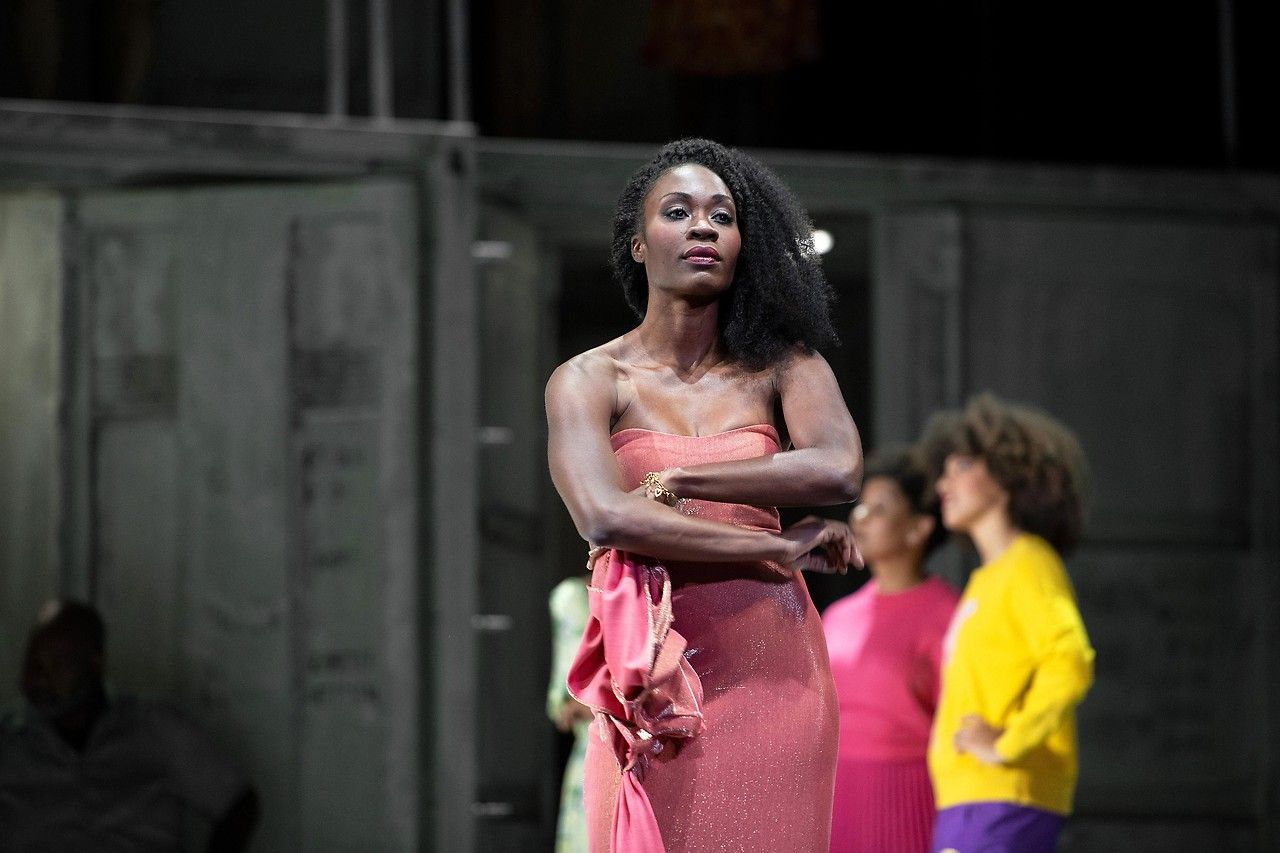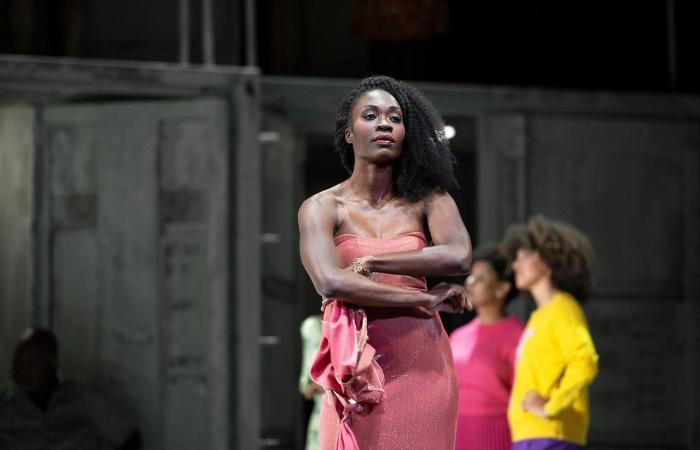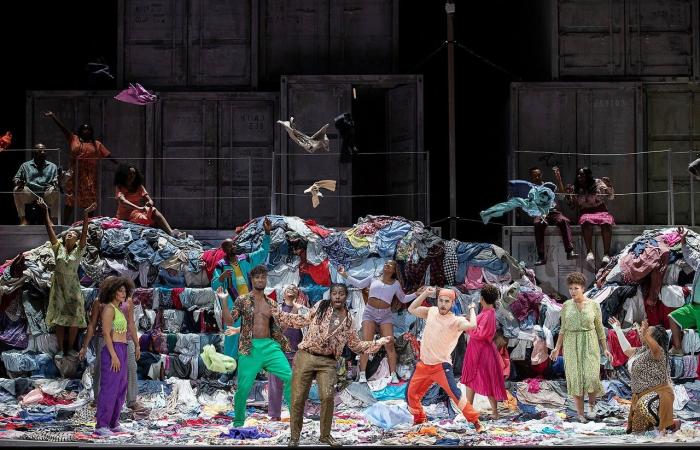According to Gershwin, he wrote an “American opera about an American subject”. Located in Catfish Row, a poor black neighborhood in the southern states, it tells the unfortunate love story between the disabled Porgy and the drug addict Bess. A violent ex-lover, a sleazy dealer without scruples, a murder, a deadly storm – in the overall composition of the opera the story, which is not lacking in twists, is still almost secondary to Gershwin’s idea of using music to draw a portrait of society.
In an interview with the program, South African director Matthew Wild emphasizes that it is important to break with the American performance tradition, in which “Porgy and Bess” is shown largely true to the original as a 1920s southern drama. He therefore decided to let the production play in the present in a refugee settlement in Europe.
Monika Rittershaus
Container storage instead of southern barracks
From a purely visual point of view, the idea is halfway through: with a room-filling turntable construction, designer Katrin Lea Tag created a container estate that provides a versatile backdrop for crowd scenes, enables parallel narratives and at the same time opens up good opportunities for intimate solo arias and duets. Associatively, however, the localization silts up right here, the colorful costumes are not familiar to the continent – and telling a “multicultural society” (quote from director Wild) with a woman wearing a headscarf is somehow impossible.
“Porgy and Bess” in the Theater an der Wien
George Gershwin’s classic opera “Porgy and Bess” premiered on Wednesday at the Theater an der Wien. Despite CoV restrictions, an international team could be put together.
Musically, the direction and anchoring in a US community is so clear that the staging hardly tries to go beyond the idea to meet its own requirements: spirituals performed with religious fervor, collective prayers, spontaneous celebrations – all of this is conventionally staged and choreographed here like from a musical textbook.
Cast according to Gershwin’s wishes
The ensemble at the Theater an der Wien complies with Gershwin’s strict requirements: only black singers are to be cast, he decreed – and compliance with this requirement is monitored by the heirs to this day. Instead of working with the Cape Town Opera ensemble in Cape Town as originally planned, an international cast had to be put together for the production at the Theater an der Wien at short notice due to the pandemic.

Monika Rittershaus
The American baritone Eric Greene plays the kind-hearted, but all too gullible Porgy, at his side is the Trinidadian soprano Jeanine De Bique as Bess, fragile but with a strong voice. As Clara, Brandie Sutton has the task of presenting the opera’s biggest hit with “Summertime”. Norman Garrett is just as well cast in the role of the murderer Crown as the particularly playful Zwakele Tshabalala as Dealer Sportin ‘Life.
At the podium of the Vienna Chamber Orchestra Special Extended (expanded with – according to the program booklet – “jazz-experienced musicians”) – Wayne Marshall is an outspoken Gershwin specialist. Under his direction, the orchestra alternates with casual precision between the many colors of the score – the blues, jazz and gospel tones, the arias and the well-composed recitative parts.

Monika Rittershaus
From Richard Wagner to Janis Joplin
According to Marshall, the composer was able to organically combine both worlds – classical composition and jazz – in his handwriting: “One source of inspiration, for example, was the work of Richard Wagner, he decidedly named the ‘Meistersinger’ as a model.”
Note
“Porgy and Bess” can still be seen in the Theater an der Wien on October 15th, 16th, 17th, 18th, 20th, 21st, 22nd, 23rd and 24th at 7:00 pm.
Nevertheless: Melodies like “I’ve got Plenty of Nothing” and “Summertime” – probably Gershwin’s best-known melody – became independent jazz standards and repeatedly conquered the international pop charts as interpreted by stars like Ella Fitzgerald and Janis Joplin. Ultimately, that is exactly the lesson from the “Porgy and Bess” success: Border crossing can be risky – but with the courage to break boundaries, other worlds can also open up.
*The article has been translated based on the content of Source link by https://orf.at/stories/3185189/
. If there is any problem regarding the content, copyright, please leave a report below the article. We will try to process as quickly as possible to protect the rights of the author. Thank you very much!
*We just want readers to access information more quickly and easily with other multilingual content, instead of information only available in a certain language.
*We always respect the copyright of the content of the author and always include the original link of the source article.If the author disagrees, just leave the report below the article, the article will be edited or deleted at the request of the author. Thanks very much! Best regards!
These were the details of the news “Porgy and Bess”: Opera on the border for this day. We hope that we have succeeded by giving you the full details and information. To follow all our news, you can subscribe to the alerts system or to one of our different systems to provide you with all that is new.
It is also worth noting that the original news has been published and is available at en24news and the editorial team at AlKhaleej Today has confirmed it and it has been modified, and it may have been completely transferred or quoted from it and you can read and follow this news from its main source.



